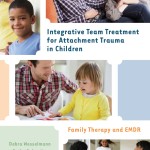 I’m a big advocate for including one or both (or more) parents into EMDR therapy with children – when parents are equipped to be supportive and when the children are comfortable with the parents being present.
I’m a big advocate for including one or both (or more) parents into EMDR therapy with children – when parents are equipped to be supportive and when the children are comfortable with the parents being present.
I prepare parents for the child’s EMDR therapy by saying something like this: “EMDR processing happens internally, so there will be long silences where your child isn’t speaking. We don’t want to interrupt this internal process, so for the most part, you’ll be a silent but comforting presence. However, I may turn to you and ask a question occasionally. I will do this when I think your child is a little stuck and when I think your natural response will be helpful.”
By keeping parents present:
- The child feels more secure.
- The parent grows in understanding for what the child has experienced.
- As the parent becomes more attuned, the child feels closer to the parent.

